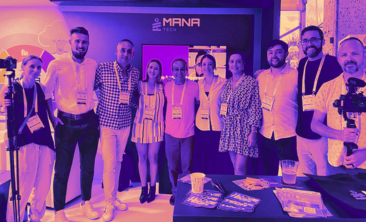
16 Ways to Boost Your Video Storytelling Strategy – Part 2
16 Ways to Boost Your Video Storytelling Strategy – Part 2 https://www.visualstorytell.com/wp-content/uploads/2016/05/May_2016_Post_Header_p2-1024x576.png 1024 576 Shlomi Ron Shlomi Ron https://secure.gravatar.com/avatar/906bcce31d9695cb030087534b5f0f6e?s=96&d=mm&r=g
When I first thought about video storytelling as a topic for this post, I figured I’ll do a top-10 list and that should cover it. Little did I know that “video well” is much deeper and I was able to extract 16 video storytelling tactics! So if you followed my part 1 post, the following are the other 8 tactics.
1. Recorded or Live Streamed Events
Objective: Share your event experience and spread your vision.
Why they’re effective: This tactic could be used in 3 ways: A) At the top of the funnel, where you can release some videos publicly to everybody in order to maximize reach, as demonstrated in this seminal TEDx talk by Simon Sinek: Start with why — how great leaders inspire action. Whereas for other high-value events, you can restrict access to your live stream as lead gen play to drive remote attendance. B) Middle-of-the-funnel, where you can release your entire event video restrictively as a premium only to paying customers/members to drive retention. Or C) A bottom-of-the funnel targeting your most promising prospects with a free video consultation or Webinar.
2. Interactive Video Ads
Objective: Drive awareness of a product or service.
Why they’re effective: In my part 1 post, I covered mostly owned and earned video tactics, so to balance the picture here is a paid media tactic that takes videos ads to the next level by adding interactivity. Video ads, in general, is a growing ad category. Video ads make up 35% of total online ad spending according to Break Media. And online video ad revenue netted $7.46B in 2015 and is set to rise to $9.59 B in 2016 (source: eMarketer)! And in case you wondered, YouTube holds 20% of the market share of total video ads in the U.S. Interactive ads perform better than standard pre-roll video ads because the user is transitioned from a passive watcher to an active participant that impacts the direction of the storyline, such as Coldplay’s interactive video for the song Ink that won the 2015 Webby Awards. According to IAB 2015 Benchmark Study, Click-through rates jump by 47% using interactive units designed for CTR, than static pre-roll video. However, sometimes the best approaches are based on a low-tech idea coupled with unexpected surprise vs. planting a complex decision tree buttons throughout a video. BBDO Toronto did just that when they created the above Skittles’s double-interactive ad, that garnered over 7 million views. The clip works because it leverages the native properties of the experience to drive a message. Viewers are asked to place their finger on a red dot on the screen and…Try it and you’ll find out.
3. Customer Testimonials
Objective: Drive demand for your product or service by leveraging 3rd party validation.
Why they’re effective: This is a classic Middle-of-the-Funnel tactic, best used for targeting qualified prospects. These prospects are in market for your product or service and just need to decide if they’re going give their business to you vs. your competitors. Why do they work? Video testimonials convey a simple brand message: don’t take our word for the benefits of our product, hear it first hand from our customers. The unfolding customer story, if crafted well, allows your prospects to imagine themselves already buying your product and how it would feel solving their problem. Almost like an imaginary trial period. In this clip, Adam, Sandwich Video founder plays the reluctant hero that is asked to participates in a Slack video that “could change the way a team communicates.” The story moves to describe the “messy way” Sandwich Video employees are currently using email to communicate – which demonstrates the problem and what is at stakes. The story then transitioned into employees’ testimonials of the various ways they now use Slack, show through these mini-stories the product benefits and how they solved their communication challenge.
4. Vlogs
Objective: Drive thought leadership and shed light on a specific topic.
Why they’re effective: First, a brief glossary lesson. In the late 1990’s blogs (short for Web log) started to appear coincided with the advent of web publishing tools (AKA WYSIWYG editors) that facilitated the posting of content by non-technical users (source: Wikipedia). Blogs, like the one you’re reading now, offer a simple and easy way to express long-form personal views and function as an engagement platform to build a following. With the emergence of YouTube in 2005, the video has become a new frontier for sharing stories – Vlogs (i.e., video blogs). In this highly entertaining vlog saddled with the attention grabber title “Snapchat Murders Facebook,” YouTube celebrity and Beme co-founder, Casey Neistat, eloquently explains what’s the whole fuss about Snapchat. His storytelling strategy offers a social media history lesson by weaving famous movie clips where actors represent various social networks and interviews with Snapchat users that serve as supporting “visual quotes.” His live Snapchat experiment with Jerome Jarre – a Vine’s celebrity – also helps to vividly demonstrate the power of the platform. And finally, Casey’s overarching narration ties this fun explainer package with high-value information that makes certain older demographics finally get a better sense about why their kids are glued to Snapchat. Is there a topic your company could use a vlog for in order to communicate and cut through the clutter?
5. Product Demos
Objective: Drive demand for a specific product or service.
Why they’re effective: This is another powerful mid to bottom-of-the-funnel tactic that works for both B2C and B2B contexts to target in-market prospects that just need to be nudged to choose your offering. Unlike testimonials that offer a third party validation, this tactic is delivered directly by the brand and is designed to convey the virtues of your product in order to trigger purchase behavior. In this clip, Zappos, the world’s largest online shoe and clothing shop that in 2009 was acquired by Amazon for $1.2B – leverages video to demo their shoes. The over-the-top presenter that demonstrates the benefit of the Puma sports shoe as if he was a car dealer singing the praise of a racing car – goes a long way to entertain while informing. This type of infotainment if aligned with your brand could help close the consideration gap for certain customer personas. The key – as always – is to match your demo style to your target audience sensibilities.
6. New Product Releases
Objective: Introduce a new product or service.
Why they’re effective: Unlike Product Demos, this top-of-the-funnel tactic can help you introduce a new product and spike initial interest by your audience. In this clip, Business Insider in collaboration with Google produced this video to introduce designers to the wonders of Tilt Brush – Google’s latest VR painting tool. Since VR is so new and not yet accessible to the masses, the storytelling technique relies on showing VR designers in action using Tilt Brush to create complex 3D designs with supporting captions to orient viewers. This visual narrative works now because the wow effect is still huge. However, with time and rise in adoption new storytelling techniques would definitely be required. The same way using the same storytelling approach for a video explaining the benefits of using email – wouldn’t work now. The lesson, pick the right storytelling approach that can do justice to your offering while sparking interest.
7. Promotions
Objective: Drive a time-sensitive demand for your product or service.
Why they’re effective: Videos are excellent storytelling vehicles as part of an integrated marketing campaign. You may be planning your Back-to-School or Christmas campaign, your overarching story is done and so are your offers. Now it’s time to plan your distribution strategy. Videos can offer intimate unmediated experience with your offering to drive awareness. In this IKEA video – Experience the power of a bookbook™ – for promoting their 2015 catalog, that on its face you’d think could have been the most boring pitch ever. Yet, instead, the clip has garnered over 18 million views based on a simple but winning storytelling formula. Typically known as “unlikely combinations.” In this case, the taken-for-granted benefits of IKEA’s paper book are contrasted with the disadvantages of an ebook or iPad, using the visual language of the latest and greatest digital gadget. This is a great example of how a brand made such a compelling story that easily transformed its audience into a revved-up storyteller.
8. Spoofs
Objective: Drive differentiating awareness of your product or service.
Why they’re effective: According to Wikipedia, the spoof is a type of satire, specifically a parody, in which an original work is made fun of by creating similar but altered work. In this clip called “A Conference Call in Real Life” YouTube comic duo Tripp & Tyler reenact a virtual conference call we all can relate to, but with the only exception that it takes place offline. Leveraging the same storytelling tactic of the IKEA video, spoofs allow you to deliver a much powerful message by borrowing the familiar attributes of unrelated environments to draw your audience in while showcasing the benefits of your offering. Like video explainers, the narrative is simplified, there is entertainment value and the format makes it super easy for your audience to relate.
What are your video storytelling insights?
Need help wowing your audience on first interaction? Schedule a FREE conversation to learn about our Experiential Explainer Videos.
- Posted In:
- Case studies
- Story Making
- Story Visualizing
- Videos
Shlomi Ron
Shlomi Ron is the founder and CEO of the Visual Storytelling Institute, a Miami-based think tank with a mission to bring the gospel of visual storytelling from the world of art to more human-centric and purpose-driven marketing. A digital marketing veteran with over 20 years of experience working both on the agency and brand sides for Fortune 100/500 brands such as Nokia, IBM, and American Express. He started VSI to combine his marketing expertise with his passion for visual stories stemming from his interests in classic Italian cinema and managing the estate of video art pioneer, Buky Schwartz. At VSI, he helps brands rise above the communication noise through visual storytelling consulting, training, and thought leadership. Select clients include Estée Lauder, Microsoft, and Cable & Wireless – to name a few. He currently teaches Brand Storytelling at the University of Miami’s Business School. Thought leader and speaker at key marketing conferences. He is also the host of the Visual Storytelling Today podcast, which ranks in the top 10 best business storytelling podcasts on the Web. His book: Total Acuity: Tales with Marketing Morals to Help You Create Richer Visual Brand Stories. Outside work, he is a nascent bread baker, The Moth fan, and longtime fedora wearer likely to jive with his classic Italian cinema interest.
All stories by: Shlomi RonYou might also like
4 comments
This site uses Akismet to reduce spam. Learn how your comment data is processed.





Leave a Reply